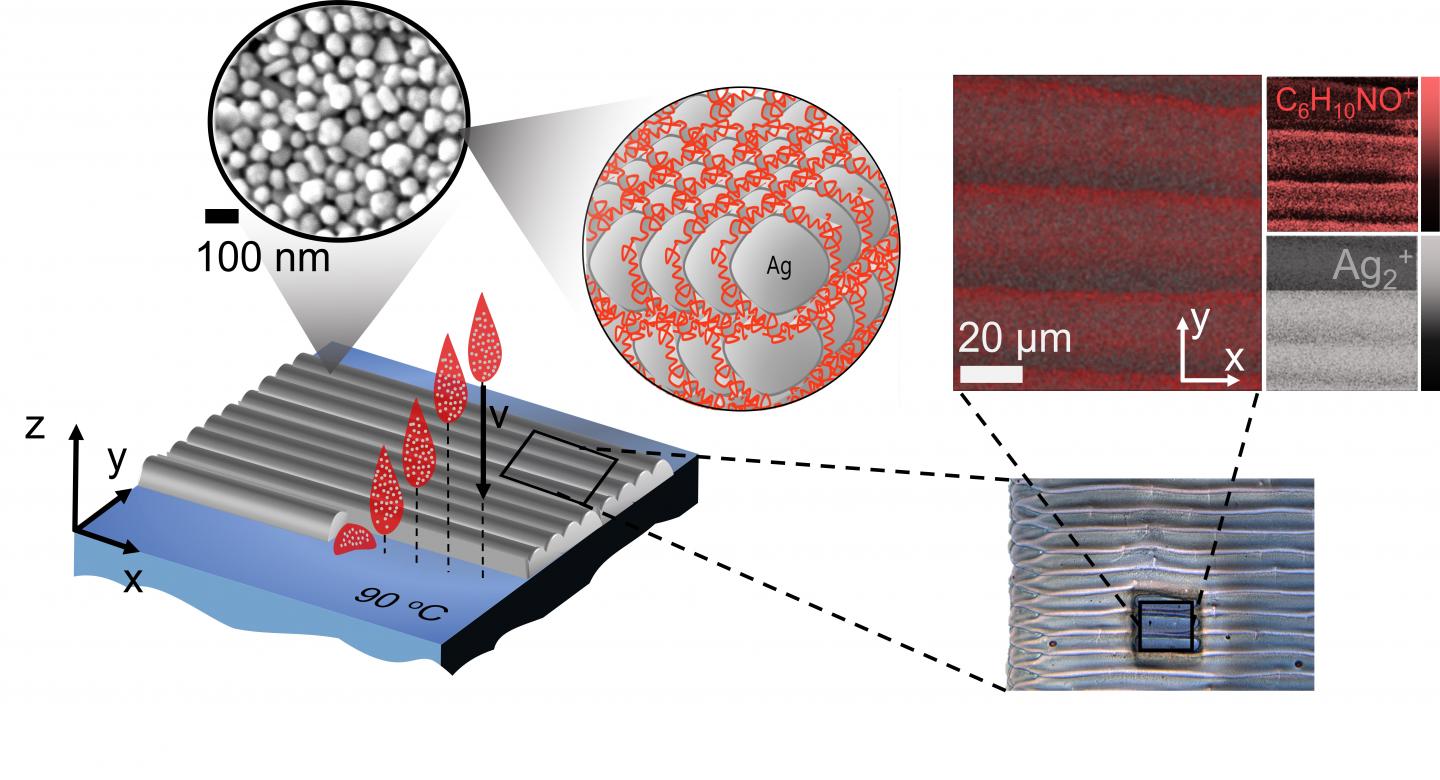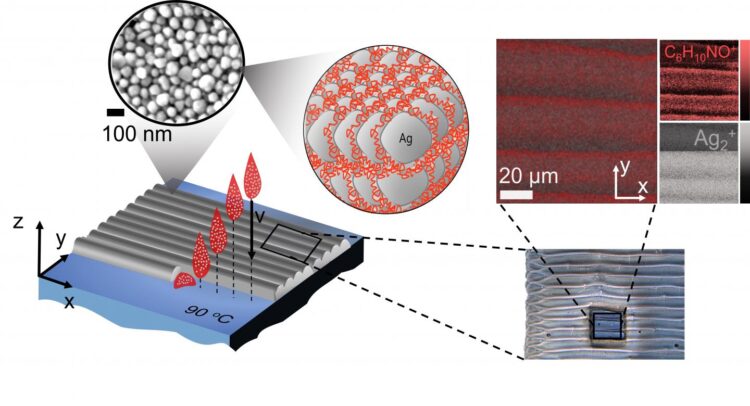
Credit: Gustavo Trindade
Inks containing metal nanoparticles are among the most commonly-used conductive materials for printed electronics. Ink-jetting layers of MNP materials allows for unpreceded design flexibility, rapid processing and 3D printing of functional electronic devices such as sensors, solar panels, LED displays, transistors and smart textiles.
Inkjet 3D printing of metals typically form a solid printed object via a two-step process: solvent evaporation upon printing (pinning) and subsequent low-temperature consolidation of nanoparticles (sintering). The low temperature is important as in many applications the nanoparticles are co-printed with other functional/structural organic materials that are sensitive to higher temperatures.
However, layers produced by inkjet printing of metal nanoparticles have different electrical conductivity between horizontal and vertical directions. This effect is known as functional anisotropy and is a long-standing problem for the 3D printing of functional electronic devices, preventing its use for advanced applications.
It was previously thought that reduced vertical conductivity through a printed device is mainly caused by shape and physical continuity problems at the interfaces of the constituent nanoparticles (at the very small micro and nanoscale). However, Nottingham researchers used silver nanoparticles to show, for the first time, that it is caused by organic chemical residues in the inks.
These residues, which are added to the inks to help stabilise the nanomaterials, lead to the formation of low-conducting, very thin nanoscale layers which interfere with the electrical conductivity of the printed sample in the vertical direction.
With a clearer understanding of the distribution of residual organic additives within printed layers, the researchers hope to go on to define new techniques and develop new ink formulations to overcome functional anisotropy of inkjet-based 3D printed electronics.
Lead author, CfAM Research Fellow Dr Gustavo Trindade, said, “The conductivity of inkjet-printed metal nanoparticles is known to be dependent on processing temperature and have been previously attributed to changes in the shape and porosity of clustered nanoparticles, with the role of organic residues being only speculated.”
“This new insight enables the development of routes to overcome functional anisotropy in inkjet-based nanoparticles, and will therefore improve uptake of this potentially transformational technology, making it competitive with conventional manufacturing. Our approach is transferable to other nanomaterial-based inks including those containing graphene and functionalised nanocrystals, and will enable the development and exploitation of both 2D and 3D printed electronics like flexible and wearable sensors, solar panels, LED displays, transistors and smart textiles.”
The study was carried out by the Centre for Additive Manufacturing (CfAM), under the £5.85m EPSRC-funded Programme Grant, Enabling Next Generation Additive Manufacturing. Their findings are published in a new paper ‘Residual polymer stabiliser causes anisotropic electrical conductivity during inkjet printing of metal nanoparticles’ in the Nature journal Communications Materials.
The researchers used the unique chemical sensitivity of a state-of-the-art 3D orbiSIMS instrument owned by the University of Nottingham. The Nottingham orbiSIMS – the only one at a UK university – allows label-free 3D chemical imaging of materials with very high resolution, revealing insights that have informed this study.
###
For a copy of the paper and media interviews contact Dr Gustavo Trindade on [email protected], or Emma Lowry Media Relations Manager (Engineering) on 0115 846 7156 or [email protected]
The University of Nottingham
The University of Nottingham is a research-intensive university with a proud heritage, consistently ranked among the world’s top 100. Studying at the University of Nottingham is a life-changing experience and we pride ourselves on unlocking the potential of our students. We have a pioneering spirit, expressed in the vision of our founder Sir Jesse Boot, which has seen us lead the way in establishing campuses in China and Malaysia – part of a globally connected network of education, research and industrial engagement. We are ranked eighth for research power in the UK according to REF 2014. We have six beacons of research excellence helping to transform lives and change the world; we are also a major employer and industry partner – locally and globally. Alongside Nottingham Trent University, we lead the Universities for Nottingham initiative, a pioneering collaboration which brings together the combined strength and civic missions of Nottingham’s two world-class universities and is working with local communities and partners to aid recovery and renewal following the COVID-19 pandemic.
CfAM
Additive manufacturing (AM) technologies, also known as 3D printing, continue to evolve rapidly into crucial 21st Century manufacturing practises. At the University of Nottingham, the Centre for Additive Manufacturing (CfAM) is at the forefront of this development. To address the exciting engineering research challenges arising from this, CfAM combines several innovative strands of engineering research to span fundamental and translational research. Implemented as an interlinked and progressive programme of research projects, our activities include the investigation of the underpinning material deposition process, the formulation and selection of entirely new materials, the exploration of new computation-based design philosophies and novel deployment approaches for a wide range of industrial sectors. Whilst always keeping a keen eye on industrial implementation the vision guiding CfAM has always had its focus ahead of the current state of the art of AM technological capability.
EPSRC Programme Grant: Enabling Next Generation Additive Manufacturing
This EPSRC Programme Grant has the ambitious goal of developing next generation AM for the in situ production of multi-functional devices.
We aim to control the co-deposition of functional and structural materials to generate whole systems, as opposed to single material component parts. Delivering this goal challenges us to establish compatibility at the interfaces where differences in the physical and chemical properties of various materials meet. The Programme’s multi-institution (Universities of Nottingham, Warwick and Birmingham) and multidisciplinary team is using state of the art equipment and approaches to analyse such interfaces, thereby accurately modelling and simulating multi-material AM – from constituent materials to multifunctional components – and developing novel materials to manufacture working electronic and bio/pharmaceutical devices.
Media Contact
Emma Lowry
[email protected]






